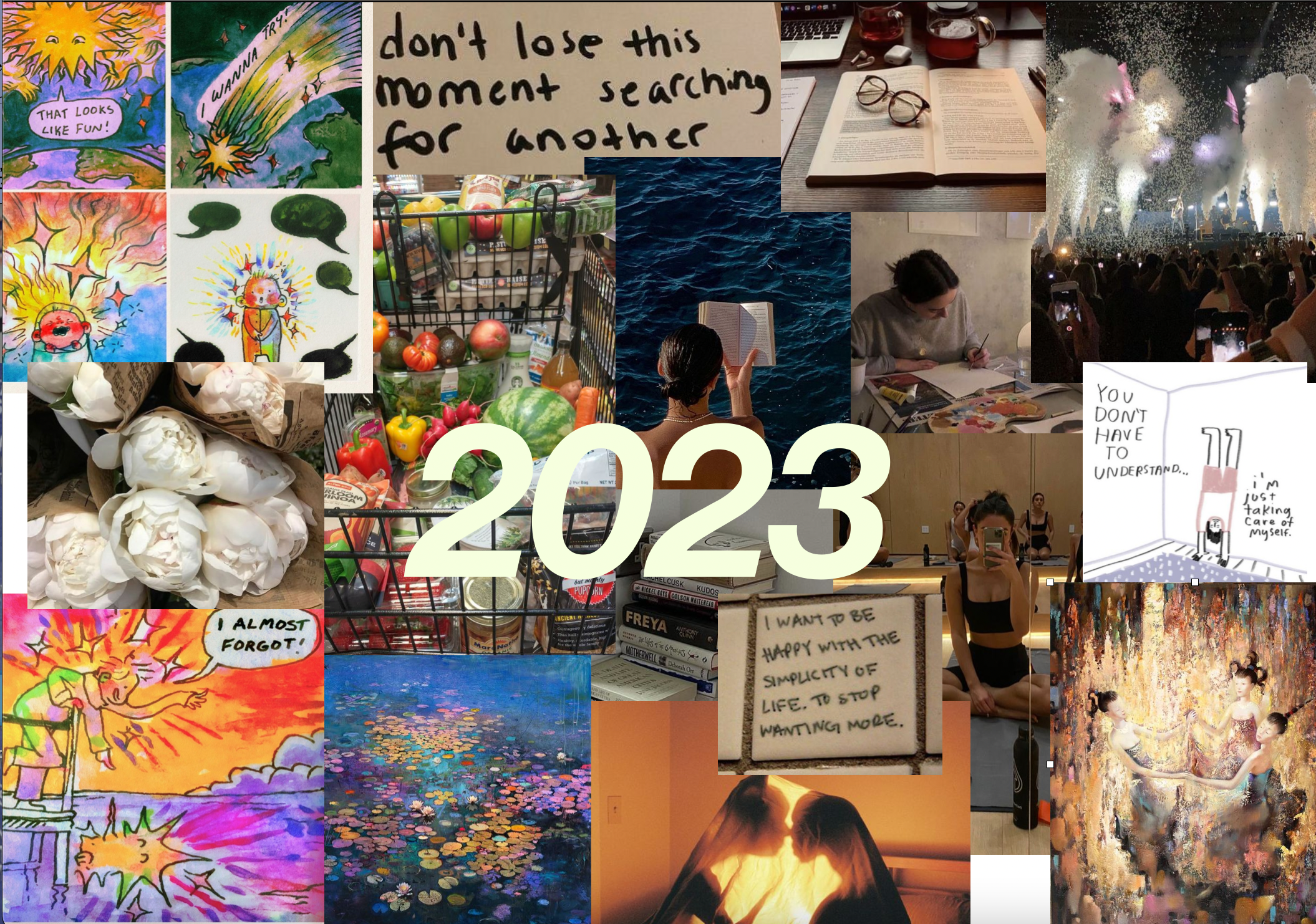
Over the past few years, manifestation, the idea that you can shape your reality through affirmations, has gained a lot of popularity, especially amongst Gen Z on platforms like TikTok. What was originally a Hindu tradition has now diverted into a broader new age spiritualism practice, often combined with the law of attraction, which states that thoughts manifest into reality. The desire to control the unexpected is human nature, but what are the cognitive implications of such a practice? The concept of manifestation is not grounded in scientific literature, but it’s nonetheless worth exploring from a psychological framework.
Over the past few years, manifestation, the idea that you can shape your reality through affirmations, has gained a lot of popularity, especially amongst Gen Z on platforms like TikTok. What was originally a Hindu tradition has now diverted into a broader new age spiritualism practice, often combined with the law of attraction, which states that thoughts manifest into reality. The desire to control the unexpected is human nature, but what are the cognitive implications of such a practice? The concept of manifestation is not grounded in scientific literature, but it’s nonetheless worth exploring from a psychological framework.

Vision Board by Ayla Farzali

Vision Board by Ayla Farzali
To manifest is to try to change your beliefs about something. This is because you can only shape your future if you believe change to be possible, and if you are willing to shape your perception accordingly. You not only declare your intentions to the moon, but you also internalise them, changing your attitudes, which are the evaluative summary of the object being perceived. These attitude changes have many cognitive and behavioural implications, from which the power of manifestation comes into fruition. Firstly, attitudes can affect perceptual processes, shifting attention to the characteristics of the object that are congruent with the established attitude (Fazio, 1986, 1990). Favourable attitudes make positive aspects of the object more salient, so while manifesting beauty will not lead to any tangible physical changes, it could instead influence how you perceive yourself by predisposing positive evaluations. Moreover, these evaluations are so powerful that corresponding behaviour can follow automatically (Hofmann, Friese, & Roefs, 2009). The theory of reasoned action explains the process behind this, stating that attitudes produce behavioural intentions, one of the most important predictors of behaviour (Fishbein & Ajzen, 1975). Therefore, to manifest something is not to passively wait for the desired results, but instead to directly affect the likelihood of engaging in behaviour that can lead to achieving said results. This direct link between attitudes and behaviour is further magnified by perceived sense of control, which makes the process of engaging and sustaining a behaviour more effective (Armitage & Reidy, 2008). Manifestation is by its very nature the perceived control over one’s future, so potentially a strong belief in one’s own capability of shaping their lives is one of the most powerful mechanisms underlying the subsequent behavioural changes in people. Therefore manifestation, through attitude change, can influence our perception and behavioural intentions, which in turn can bring us closer to the future we envisioned.
Moreover, manifestation also affects cognitive reappraisal, the practice of regulating emotions by re-evaluating thought patterns. The act of judging automatic thoughts against the standards you manifested can realign your cognitive processes to be congruent with how you want to perceive the world and yourself, which in turn affects emotions. This can indeed be an effortful process, which differs from the idea that manifestation doesn’t require any input beyond setting intentions, but once your manifested beliefs are more well established this process can become rather automatic. This is because through the development of schemas (i.e. mental representations of the world), which are in line with what you manifested, any schema-congruent information will be prioritised over information that differs from your beliefs (Clark, 2013). Importantly, manifestation requires belief in your intentions, so it could be understood as the process through which optimism is established. Once automatic thoughts have been re-evaluated, and your manifested beliefs are brought to consciousness, the brain does the rest of the work and adjusts your emotional responses to be consistent with your beliefs. The engagement of the brain’s frontoparietal attention system in the cognitive reappraisal subsequently suppresses the amygdala’s negative emotional responses (Diekhof et al. 2011), and through this, the manifestation of a more positive reality becomes possible. This demonstrates the pervasive power of thoughts being able to influence what we deem as less controllable aspects of our psyche, such as undesired emotional reactions. Moreover, the effectiveness of cognitive reappraisal is grounded in empirical evidence, an insight often used in many types of therapy, such as cognitive behavioral therapy (Beck 2005), and dialectical behavioral therapy (Lynch et al. 2007). Therefore, beliefs are a core aspect of how we experience reality, and manifestation is a way for you to establish how to best perceive the world in a way that suits your intentions.
“You not only declare your intentions to the moon, but you also internalise them, changing your attitudes, which are the evaluative summary of the object being perceived.”
But how can manifestation most effectively result in the desired outcomes? The first step is to form specific intentions, as they have been shown to better achieve behavioural goals (Gollwitzer & Sheeran, 2006). The essential part is to make your goals concrete, so that it’s easier to follow them with behaviour that will result in what you manifested. After that, there are a few ways to form attitudes that are more easily accessible so that behaviour can follow automatically, which is more akin to the idea of manifestation, since it would involve less conscious effort. Firstly, attitudes should be activated along with the attitude object, instead of being solely abstract ideas (Fazio & Zanna, 1981). The implementation of this will differ depending on what you are trying to manifest, but simply remembering your intentions when you encounter the object related to your manifestation can be one way to go about it. Secondly, attitudes formed through systematic processing lead to more attitude-consistent behaviour (Pierro, Mannetti, Kruglanski, Klein, & Orehek, 2012). This can be achieved by allocating enough time to set your intentions and doing that in an environment that is free from distractions. Lastly, believe in what you manifest! Stronger attitudes, which are confidently held, have a very high attitude-behaviour consistency (Costarelli & Colloca, 2007). From this, a strong belief can automatically lead to behaviour, eventually resulting in what you manifested. While this is quite different from setting your intentions and watching your future unfold before you, it is still a way through which your beliefs can manifest into reality.
In conclusion, while the universe may not be granting you your wishes, in a way you can still envision a better reality and bring it to fruition through your own will. Having a more optimistic view of the world can only bring you benefits, and the idea that establishing your intentions can help you achieve them is something that is grounded in empirical evidence. If you effectively change your attitudes through the practice of manifestation, your perception of attitude-objects will also change, and from this behaviour congruent with your intentions will be easier to carry out, and your emotional experiences can become more positive. So manifest to your heart’s desires! Don’t just passively wait for things to get better, but ask yourself what you want. And of course, follow through on trying to achieve your intentions yourself – or don’t, maybe the universe is indeed more powerful than psychology but that is unfortunately beyond the scope of this article.
References
-
Armitage, C. J., & Reidy, J. G. (2008). Use of mental simulations to change theory of planned behaviour variables. British Journal of Health Psychology, 13(3), 513–524. https://doi.org/10.1348/135910707X227088
-
Clark, D.A. (2013). Cognitive Restructuring. In The Wiley Handbook of Cognitive Behavioral Therapy, S.G. Hofmann (Ed.). https://doi.org/10.1002/9781118528563.wbcbt02
-
Costarelli, S., & Colloca, P. (2007). The moderation of ambivalence on attitude-intention relations as mediated by attitude importance. European Journal of Social Psychology, 37(5), 923–933. https://doi.org/10.1002/ejsp.403
-
Diekhof, Esther & Geier, Katharina & Falkai, Peter & Gruber, Oliver. (2011). Fear is only as deep as the mind allows:: A coordinate-based meta-analysis of neuroimaging studies on the regulation of negative affect. NeuroImage. 58. 275-85. 10.1016/j.neuroimage.2011.05.073.
-
Fazio, R. H., & Zanna, M. P. (1981). Direct Experience And Attitude-Behavior Consistency. Elsevier EBooks, 161–202. https://doi.org/10.1016/s0065-2601(08)60372-x
-
Fishbein, M. & Ajzen, Icek. (1975). Belief, attitude, intention and behaviour: An introduction to theory and research.
-
Gollwitzer, Peter & Sheeran, Paschal. (2006). Implementation Intentions and Goal Achievement: A Meta-Analysis of Effects and Processes. First publ. in: Advances in Experimental Social Psychology 38 (2006), pp. 69-119. 38. 10.1016/S0065-2601(06)38002-1.
-
Hofmann, W., Friese, M., & Roefs, A. (2009). Three ways to resist temptation: The independent contributions of executive attention, inhibitory control, and affect regulation to the impulse control of eating behavior. Journal of Experimental Social Psychology, 45(2), 431–435. https://doi.org/10.1016/j.jesp.2008.09.013
-
Lynch, Thomas & Trost, William & Salsman, Nicholas & Linehan, Marsha. (2007). Dialectical Behavior Therapy for Borderline Personality Disorder. Annual review of clinical psychology. 3. 181-205. 10.1146/annurev.clinpsy.2.022305.095229.
-
Pierro, A., Mannetti, L., Kruglanski, A. W., Klein, K., & Orehek, E. (2012). Persistence of attitude change and attitude–behavior correspondence based on extensive processing of source information. European Journal of Social Psychology, 42(1), 103–111. https://doi.org/10.1002/ejsp.853
To manifest is to try to change your beliefs about something. This is because you can only shape your future if you believe change to be possible, and if you are willing to shape your perception accordingly. You not only declare your intentions to the moon, but you also internalise them, changing your attitudes, which are the evaluative summary of the object being perceived. These attitude changes have many cognitive and behavioural implications, from which the power of manifestation comes into fruition. Firstly, attitudes can affect perceptual processes, shifting attention to the characteristics of the object that are congruent with the established attitude (Fazio, 1986, 1990). Favourable attitudes make positive aspects of the object more salient, so while manifesting beauty will not lead to any tangible physical changes, it could instead influence how you perceive yourself by predisposing positive evaluations. Moreover, these evaluations are so powerful that corresponding behaviour can follow automatically (Hofmann, Friese, & Roefs, 2009). The theory of reasoned action explains the process behind this, stating that attitudes produce behavioural intentions, one of the most important predictors of behaviour (Fishbein & Ajzen, 1975). Therefore, to manifest something is not to passively wait for the desired results, but instead to directly affect the likelihood of engaging in behaviour that can lead to achieving said results. This direct link between attitudes and behaviour is further magnified by perceived sense of control, which makes the process of engaging and sustaining a behaviour more effective (Armitage & Reidy, 2008). Manifestation is by its very nature the perceived control over one’s future, so potentially a strong belief in one’s own capability of shaping their lives is one of the most powerful mechanisms underlying the subsequent behavioural changes in people. Therefore manifestation, through attitude change, can influence our perception and behavioural intentions, which in turn can bring us closer to the future we envisioned.
Moreover, manifestation also affects cognitive reappraisal, the practice of regulating emotions by re-evaluating thought patterns. The act of judging automatic thoughts against the standards you manifested can realign your cognitive processes to be congruent with how you want to perceive the world and yourself, which in turn affects emotions. This can indeed be an effortful process, which differs from the idea that manifestation doesn’t require any input beyond setting intentions, but once your manifested beliefs are more well established this process can become rather automatic. This is because through the development of schemas (i.e. mental representations of the world), which are in line with what you manifested, any schema-congruent information will be prioritised over information that differs from your beliefs (Clark, 2013). Importantly, manifestation requires belief in your intentions, so it could be understood as the process through which optimism is established. Once automatic thoughts have been re-evaluated, and your manifested beliefs are brought to consciousness, the brain does the rest of the work and adjusts your emotional responses to be consistent with your beliefs. The engagement of the brain’s frontoparietal attention system in the cognitive reappraisal subsequently suppresses the amygdala’s negative emotional responses (Diekhof et al. 2011), and through this, the manifestation of a more positive reality becomes possible. This demonstrates the pervasive power of thoughts being able to influence what we deem as less controllable aspects of our psyche, such as undesired emotional reactions. Moreover, the effectiveness of cognitive reappraisal is grounded in empirical evidence, an insight often used in many types of therapy, such as cognitive behavioral therapy (Beck 2005), and dialectical behavioral therapy (Lynch et al. 2007). Therefore, beliefs are a core aspect of how we experience reality, and manifestation is a way for you to establish how to best perceive the world in a way that suits your intentions.
“You not only declare your intentions to the moon, but you also internalise them, changing your attitudes, which are the evaluative summary of the object being perceived.”
But how can manifestation most effectively result in the desired outcomes? The first step is to form specific intentions, as they have been shown to better achieve behavioural goals (Gollwitzer & Sheeran, 2006). The essential part is to make your goals concrete, so that it’s easier to follow them with behaviour that will result in what you manifested. After that, there are a few ways to form attitudes that are more easily accessible so that behaviour can follow automatically, which is more akin to the idea of manifestation, since it would involve less conscious effort. Firstly, attitudes should be activated along with the attitude object, instead of being solely abstract ideas (Fazio & Zanna, 1981). The implementation of this will differ depending on what you are trying to manifest, but simply remembering your intentions when you encounter the object related to your manifestation can be one way to go about it. Secondly, attitudes formed through systematic processing lead to more attitude-consistent behaviour (Pierro, Mannetti, Kruglanski, Klein, & Orehek, 2012). This can be achieved by allocating enough time to set your intentions and doing that in an environment that is free from distractions. Lastly, believe in what you manifest! Stronger attitudes, which are confidently held, have a very high attitude-behaviour consistency (Costarelli & Colloca, 2007). From this, a strong belief can automatically lead to behaviour, eventually resulting in what you manifested. While this is quite different from setting your intentions and watching your future unfold before you, it is still a way through which your beliefs can manifest into reality.
In conclusion, while the universe may not be granting you your wishes, in a way you can still envision a better reality and bring it to fruition through your own will. Having a more optimistic view of the world can only bring you benefits, and the idea that establishing your intentions can help you achieve them is something that is grounded in empirical evidence. If you effectively change your attitudes through the practice of manifestation, your perception of attitude-objects will also change, and from this behaviour congruent with your intentions will be easier to carry out, and your emotional experiences can become more positive. So manifest to your heart’s desires! Don’t just passively wait for things to get better, but ask yourself what you want. And of course, follow through on trying to achieve your intentions yourself – or don’t, maybe the universe is indeed more powerful than psychology but that is unfortunately beyond the scope of this article.
References
-
Armitage, C. J., & Reidy, J. G. (2008). Use of mental simulations to change theory of planned behaviour variables. British Journal of Health Psychology, 13(3), 513–524. https://doi.org/10.1348/135910707X227088
-
Clark, D.A. (2013). Cognitive Restructuring. In The Wiley Handbook of Cognitive Behavioral Therapy, S.G. Hofmann (Ed.). https://doi.org/10.1002/9781118528563.wbcbt02
-
Costarelli, S., & Colloca, P. (2007). The moderation of ambivalence on attitude-intention relations as mediated by attitude importance. European Journal of Social Psychology, 37(5), 923–933. https://doi.org/10.1002/ejsp.403
-
Diekhof, Esther & Geier, Katharina & Falkai, Peter & Gruber, Oliver. (2011). Fear is only as deep as the mind allows:: A coordinate-based meta-analysis of neuroimaging studies on the regulation of negative affect. NeuroImage. 58. 275-85. 10.1016/j.neuroimage.2011.05.073.
-
Fazio, R. H., & Zanna, M. P. (1981). Direct Experience And Attitude-Behavior Consistency. Elsevier EBooks, 161–202. https://doi.org/10.1016/s0065-2601(08)60372-x
-
Fishbein, M. & Ajzen, Icek. (1975). Belief, attitude, intention and behaviour: An introduction to theory and research.
-
Gollwitzer, Peter & Sheeran, Paschal. (2006). Implementation Intentions and Goal Achievement: A Meta-Analysis of Effects and Processes. First publ. in: Advances in Experimental Social Psychology 38 (2006), pp. 69-119. 38. 10.1016/S0065-2601(06)38002-1.
-
Hofmann, W., Friese, M., & Roefs, A. (2009). Three ways to resist temptation: The independent contributions of executive attention, inhibitory control, and affect regulation to the impulse control of eating behavior. Journal of Experimental Social Psychology, 45(2), 431–435. https://doi.org/10.1016/j.jesp.2008.09.013
-
Lynch, Thomas & Trost, William & Salsman, Nicholas & Linehan, Marsha. (2007). Dialectical Behavior Therapy for Borderline Personality Disorder. Annual review of clinical psychology. 3. 181-205. 10.1146/annurev.clinpsy.2.022305.095229.
-
Pierro, A., Mannetti, L., Kruglanski, A. W., Klein, K., & Orehek, E. (2012). Persistence of attitude change and attitude–behavior correspondence based on extensive processing of source information. European Journal of Social Psychology, 42(1), 103–111. https://doi.org/10.1002/ejsp.853



